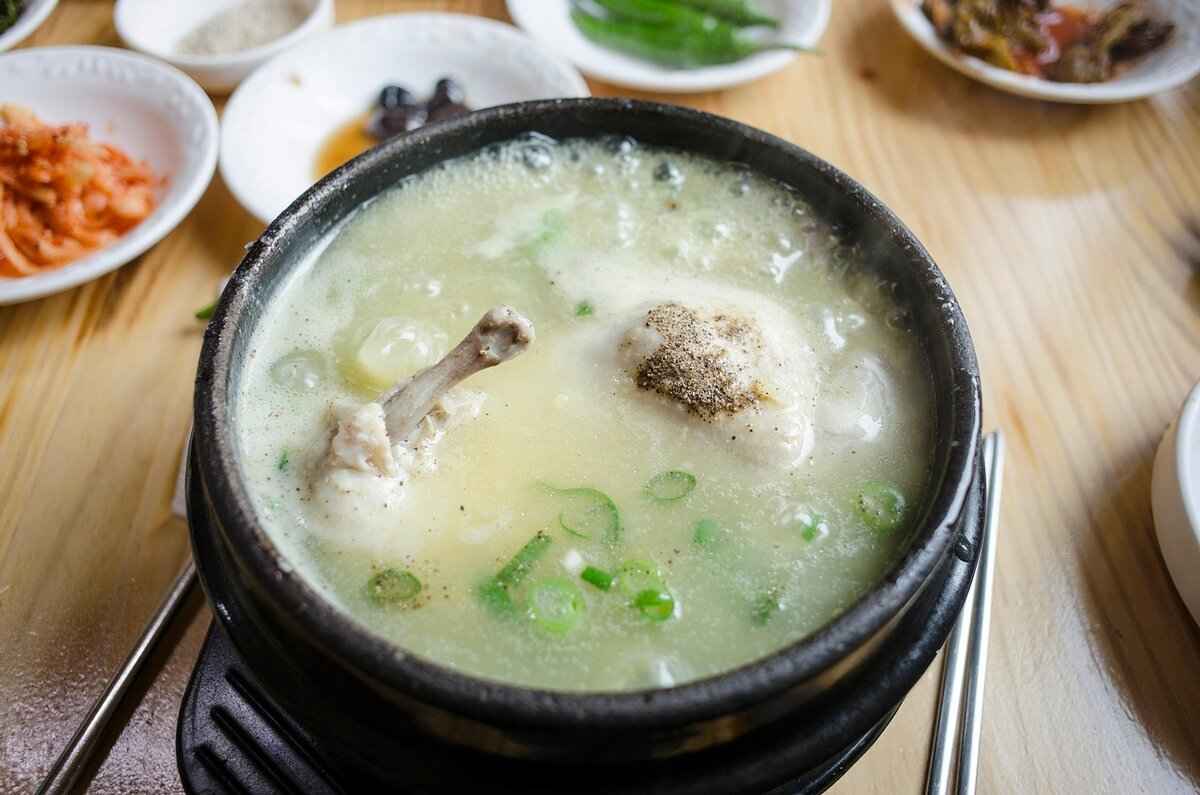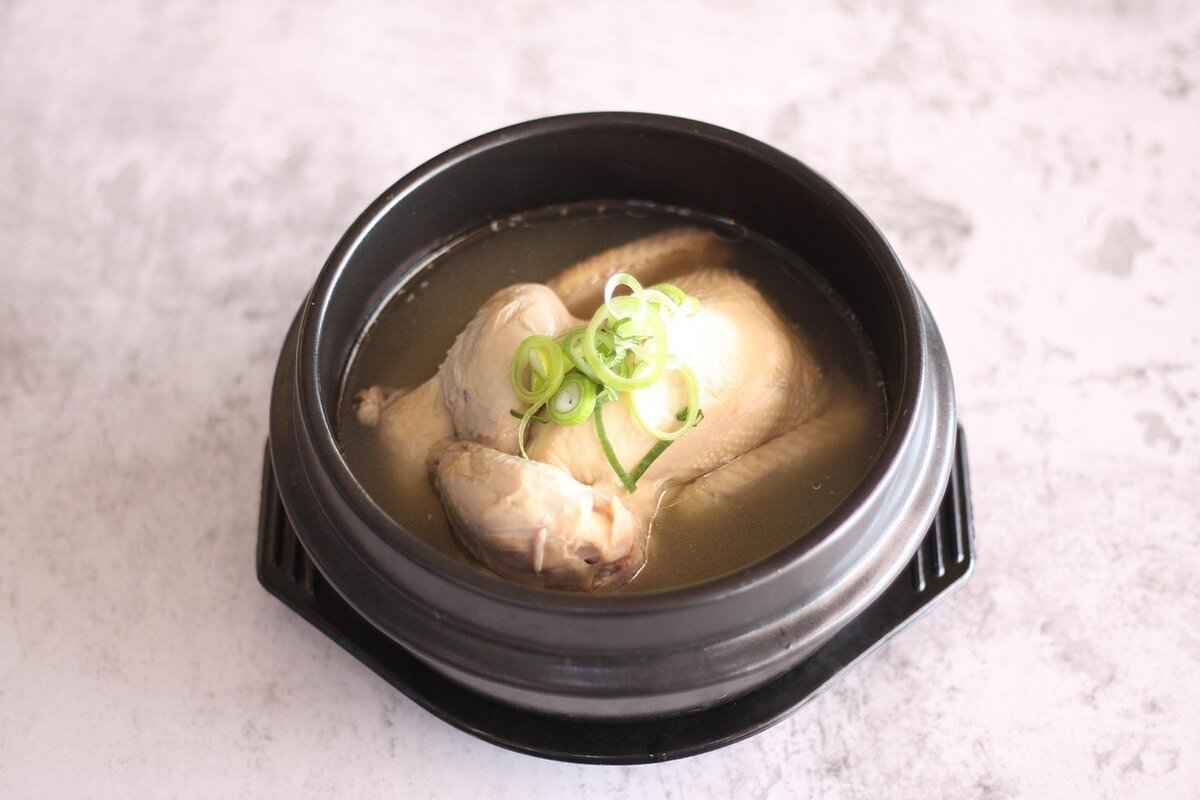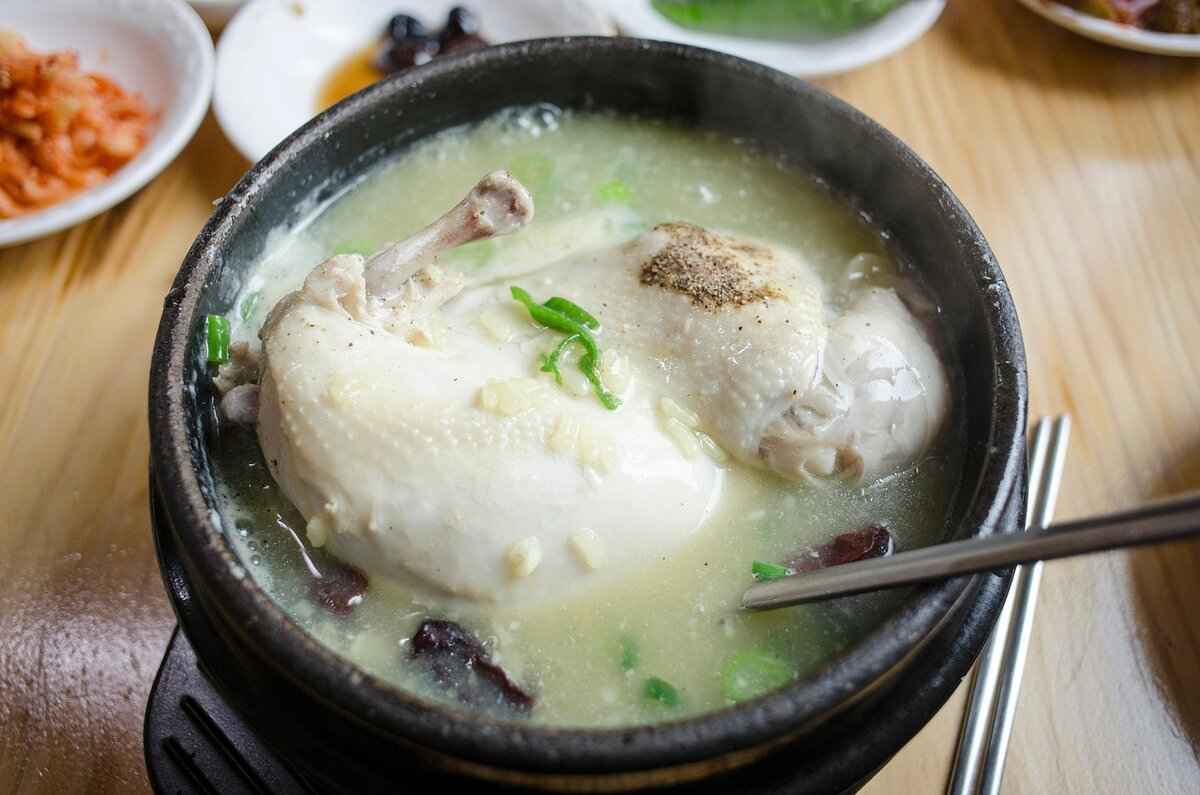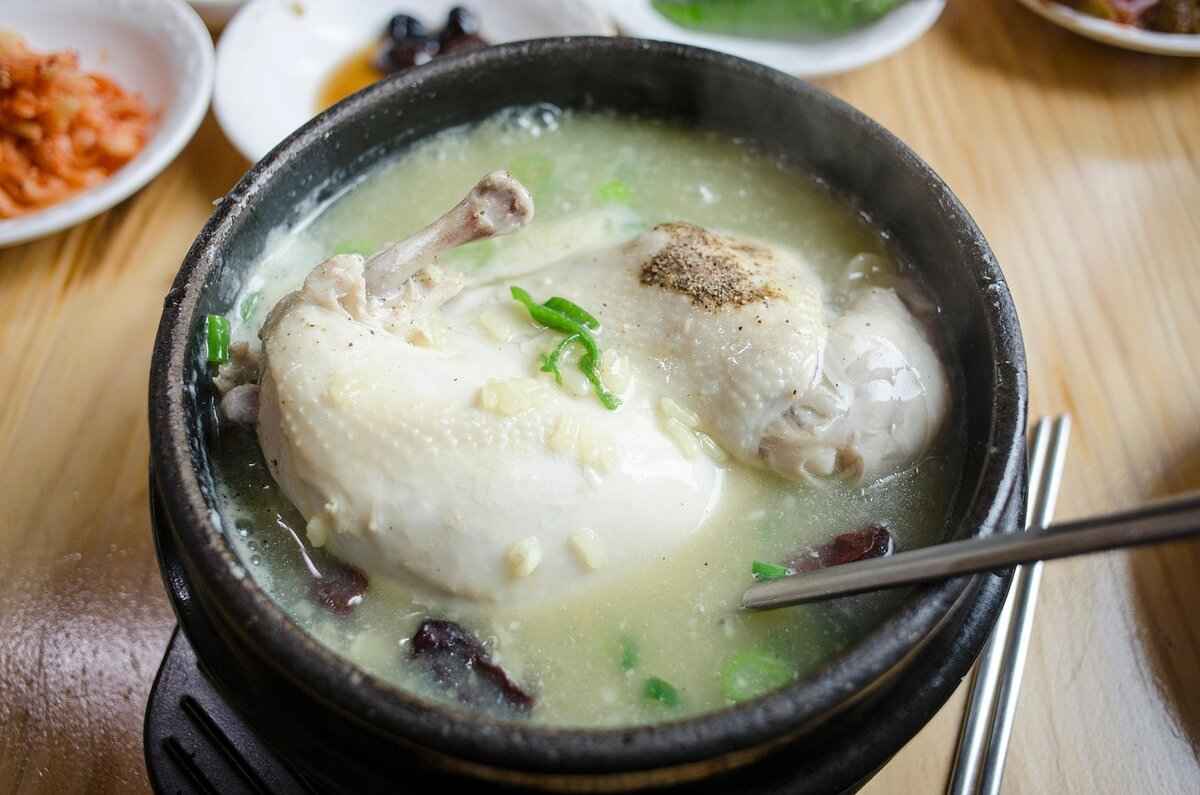Samgyetang, a traditional Korean dish, is renowned for its remarkable health benefits and cultural significance. This comforting soup, made with a whole young chicken, is not only delicious but also rich in nutrients, making it a staple during the hot summer months. Let’s delve deeper into the benefits, ingredients, and the cultural importance of this beloved dish.
Samgyetang is a nourishing soup that features a whole young chicken filled with ginseng, garlic, and glutinous rice. This dish is celebrated for its revitalizing qualities, often consumed to restore energy and promote health, especially during the sweltering summer.
This hearty soup is packed with essential nutrients that support the immune system and enhance energy levels. Its rich composition makes it a popular choice for those seeking natural remedies. Regular consumption of Samgyetang is believed to:
- Boost immunity and help the body fight off illnesses.
- Increase energy levels, making it ideal for hot summer days.
- Provide a comforting and nourishing meal that aids in recovery from fatigue.
One of the key ingredients in Samgyetang is ginseng, renowned for its adaptogenic properties. This powerful herb helps the body manage stress and enhances overall vitality. Ginseng is not only a flavor enhancer but also contributes significantly to the soup’s health benefits.
Research indicates that ginseng can enhance immune function, potentially reducing the risk of infections. Its presence in Samgyetang makes this dish a vital component of Korean culinary tradition, especially during the summer months.
In addition to ginseng, Samgyetang typically includes:
- Jujubes – known for their sweet flavor and health benefits.
- Garlic – adds depth of flavor and has immune-boosting properties.
- Glutinous rice – serves as a stuffing that absorbs the flavors of the broth.
Traditional preparation of Samgyetang involves slow-cooking the chicken, allowing the flavors to meld into a rich, nourishing broth. This method ensures that the chicken remains tender and juicy, creating a comforting dish that is both satisfying and healthy.
The boiling method is commonly used to prepare Samgyetang, allowing all the ingredients to infuse their flavors into the broth. This technique results in a soothing and nutritious soup that is perfect for hot summer days.
While traditional recipes are cherished, many variations exist. Chefs often customize Samgyetang by adding different herbs, vegetables, or spices to cater to individual tastes or dietary needs. This flexibility allows everyone to enjoy this nutritious dish.
Samgyetang is traditionally enjoyed during the summer months in Korea, particularly on the hottest days. It is believed to replenish energy and combat heat fatigue, making it a seasonal favorite.
Beyond its nutritional benefits, Samgyetang symbolizes health and vitality in Korean culture. It is often served during special occasions or to aid in recovery from illness, reflecting its importance in Korean culinary traditions.
Typically served hot, Samgyetang is accompanied by side dishes such as kimchi and pickled vegetables. These additions enhance the dining experience, providing a balanced meal that is both flavorful and nutritious.

What is Samgyetang?
Samgyetang is not just a dish; it is a cultural emblem of Korea, particularly cherished for its delicious flavor and remarkable health benefits. This traditional soup features a whole young chicken, meticulously prepared and stuffed with a blend of ginseng, garlic, and glutinous rice. The combination of these ingredients is celebrated for its nourishing properties, making Samgyetang a popular choice among those seeking to enhance their well-being.
At its core, Samgyetang is a hearty soup that is rich in flavor and nutrients. The dish is prepared by boiling a whole young chicken, which is then filled with a mixture of ginseng, garlic, and glutinous rice. This cooking method allows the flavors to meld together, resulting in a savory broth that is both soothing and invigorating. Traditionally served hot, Samgyetang is especially enjoyed during the sweltering summer months, as it is believed to replenish energy and combat the fatigue associated with high temperatures.
Samgyetang is renowned for its health-boosting properties. The dish is loaded with essential nutrients that help support the immune system, increase energy levels, and promote overall wellness. Ginseng, in particular, is a key ingredient known for its adaptogenic properties, which assist the body in resisting stress and enhancing vitality. This makes Samgyetang an ideal choice for those looking to maintain their health naturally.
Ginseng plays a pivotal role in Samgyetang, recognized for its numerous health benefits. It is often referred to as a superfood due to its ability to improve energy levels and support the immune system. The adaptogenic qualities of ginseng help the body adapt to various stressors, making it a vital addition to this traditional dish.
Research indicates that ginseng can enhance immune function, potentially lowering the risk of infections and illnesses. This makes it an essential component of Samgyetang, as the combination of ginseng and chicken creates a powerful dish that supports health and recovery.
Yes, there are several types of ginseng, including Korean Red Ginseng and American Ginseng. Each variety offers unique health benefits and flavors that can elevate the taste of Samgyetang. Korean Red Ginseng, for instance, is particularly favored for its robust flavor and potent health properties.
In addition to ginseng, Samgyetang typically includes other nourishing ingredients such as jujubes, garlic, and glutinous rice. These ingredients not only enhance the flavor of the soup but also contribute to its health benefits. Jujubes, for example, are known for their antioxidant properties, adding another layer of nutrition to this beloved dish.
The preparation of Samgyetang is steeped in tradition. The whole chicken is carefully cleaned and stuffed with the ginseng, garlic, and rice mixture. It is then slow-cooked, allowing the flavors to develop and the meat to become tender and juicy. This meticulous cooking process ensures that every bowl of Samgyetang is both delicious and nourishing.
Samgyetang is primarily prepared using a boiling method. This technique enables the ingredients to meld together, creating a rich and flavorful broth. The slow cooking process also ensures that the chicken remains moist and tender, making it a comforting meal.
While traditional Samgyetang recipes are cherished, many variations exist. Cooks can customize the dish by adding different herbs, vegetables, or spices to cater to individual tastes and dietary needs. This flexibility allows for a personalized experience while still enjoying the core benefits of the dish.
Traditionally, Samgyetang is enjoyed during the summer months in Korea, particularly on the hottest days. It is believed to help replenish energy and combat heat fatigue, making it a seasonal favorite.
More than just a meal, Samgyetang symbolizes health and vitality in Korean culture. It is often served during special occasions or to aid recovery from illness, reflecting its importance in promoting wellness.
Samgyetang is typically served hot and accompanied by side dishes like kimchi and pickled vegetables. These side dishes enhance the dining experience, providing a balanced meal that is both satisfying and nourishing.

What Are the Health Benefits of Samgyetang?
Samgyetang, the traditional Korean ginseng chicken soup, is more than just a comforting dish; it is a powerhouse of nutrients that offers numerous health benefits. This hearty meal is particularly popular during the summer months when it is believed to replenish energy and combat heat fatigue. Let’s explore the various health benefits of Samgyetang in detail.
Samgyetang is known for its ability to support the immune system, boost energy levels, and promote overall wellness. Here’s how:
- Immune System Support: The combination of ingredients in Samgyetang, particularly ginseng and garlic, plays a crucial role in enhancing immune function. Ginseng is recognized for its adaptogenic properties, which help the body adapt to stress and improve overall vitality. Garlic, known for its antibacterial and antiviral properties, further strengthens the immune response.
- Energy Boost: The slow-cooked chicken provides a rich source of protein, essential for muscle repair and energy production. Additionally, ginseng is renowned for its ability to increase stamina and reduce fatigue, making Samgyetang an excellent choice for those needing an energy boost.
- Rich in Nutrients: Samgyetang is packed with vitamins and minerals. The use of jujubes (red dates) adds antioxidants, which help combat oxidative stress, while glutinous rice provides carbohydrates for energy. Together, these ingredients create a nutrient-dense meal that supports overall health.
- Digestive Health: The soup is gentle on the stomach, making it an ideal meal for those recovering from illness. The combination of warm broth and wholesome ingredients aids digestion and promotes gut health.
- Hydration: Consuming a warm soup helps with hydration, especially during hot summer days. Staying hydrated is essential for maintaining energy levels and overall health.
Ginseng is often considered the star ingredient in Samgyetang. Its adaptogenic properties help the body resist stress and improve energy levels. Studies have shown that ginseng can enhance cognitive function and physical performance, making it a vital component of this nourishing soup.
Research indicates that ginseng can enhance immune function by stimulating the production of immune cells. This is particularly beneficial in reducing the risk of infections and illnesses, making it an essential ingredient in Samgyetang.
In addition to ginseng, Samgyetang typically includes:
- Whole young chicken
- Garlic
- Glutinous rice
- Jujubes (red dates)
- Ginger
Each ingredient contributes to the dish’s rich flavor and health benefits, creating a harmonious blend of taste and nutrition.
The preparation of Samgyetang involves a slow-cooking method that allows the flavors to meld together. The chicken is typically boiled until tender, ensuring that the broth is infused with all the nutrients and flavors from the ingredients.
Traditionally, Samgyetang is enjoyed during the summer months in Korea, particularly on the hottest days. It is believed to replenish energy and combat heat fatigue, making it a beloved seasonal dish.
Beyond its health benefits, Samgyetang is a symbol of health and vitality in Korean culture. It is often served during special occasions or to aid recovery from illness, reflecting its importance in promoting wellness.
Typically served hot, Samgyetang is accompanied by side dishes like kimchi and pickled vegetables, enhancing the dining experience and providing a balanced meal. The combination of flavors and textures makes it a delightful and nourishing dish.
Why is Ginseng Important in Samgyetang?
Ginseng, a revered herb in traditional medicine, plays a pivotal role in Samgyetang, the beloved Korean ginseng chicken soup. This ancient ingredient is not just a flavor enhancer; it is a powerhouse of health benefits, making it an essential component of this nourishing dish. Rich in adaptogenic properties, ginseng helps the body adapt to stress and boosts overall vitality.
Understanding Ginseng’s Adaptogenic Properties
Adaptogens are natural substances that help the body manage stress. Ginseng, particularly Korean Red Ginseng, is known for its ability to modulate the body’s response to various stressors. By incorporating ginseng into Samgyetang, the dish not only provides comfort but also aids in enhancing energy levels and reducing fatigue, making it a perfect meal for those needing a revitalizing boost.
Boosting Immunity with Ginseng
Research indicates that ginseng can significantly enhance the immune system. Its active compounds, known as ginsenosides, have been shown to stimulate the production of immune cells, thus potentially reducing the risk of infections. During the summer months, when many people experience heat fatigue, consuming Samgyetang can help replenish energy and strengthen immunity, making it a popular choice for health-conscious individuals.
The Nutritional Synergy of Samgyetang
In addition to ginseng, Samgyetang is typically prepared with a whole young chicken, garlic, glutinous rice, and jujubes. Each ingredient contributes to the overall health benefits of the soup. For instance, garlic possesses its own immune-boosting properties, while jujubes are rich in vitamins and minerals. The combination of these ingredients creates a nutrient-dense dish that supports overall wellness.
Exploring Different Types of Ginseng
There are several varieties of ginseng, each offering unique health benefits. Korean Red Ginseng is particularly prized for its potent effects on energy and immunity. In contrast, American Ginseng is often milder and is thought to have calming properties. Depending on the type used, the flavor and health benefits of Samgyetang can vary, allowing for personalization according to individual preferences and health goals.
Traditional Preparation and Its Impact on Flavor
The preparation of Samgyetang is steeped in tradition, often involving slow-cooking the chicken to create a rich, flavorful broth. This method allows the nutrients from ginseng and other ingredients to infuse the soup, enhancing its health benefits. The result is a dish that is not only delicious but also deeply nourishing, making it a staple in Korean households.
How to Enjoy Samgyetang for Maximum Benefits
To fully appreciate the health benefits of Samgyetang, it is best enjoyed hot, often accompanied by traditional side dishes like kimchi and pickled vegetables. These sides complement the soup’s flavors and provide additional nutrients, creating a balanced meal that supports health and vitality.
Conclusion
In summary, ginseng is a crucial ingredient in Samgyetang, contributing to its status as a health-boosting dish. With its adaptogenic properties, immune-boosting capabilities, and nutritional synergy with other ingredients, ginseng not only enhances the flavor but also elevates the health benefits of this traditional Korean soup. Whether enjoyed on a hot summer day or as a comforting meal during colder months, Samgyetang remains a cherished dish that embodies the essence of Korean culinary tradition.
How Does Ginseng Support Immunity?
Ginseng has long been celebrated in traditional medicine for its myriad health benefits, particularly its role in enhancing the body’s immune function. This ancient herb, especially prominent in Korean culture, is a vital ingredient in many dishes, including the renowned Samgyetang, a nourishing chicken soup. Understanding how ginseng supports immunity can help individuals appreciate its significance not just as a culinary delight, but as a powerful health ally.
Research indicates that ginseng contains active compounds known as ginsenosides, which play a crucial role in modulating immune responses. These compounds have been shown to enhance the activity of various immune cells, such as natural killer (NK) cells and macrophages, which are essential in defending the body against infections.
- Increased Production of Immune Cells: Studies suggest that ginseng can stimulate the production of lymphocytes, a type of white blood cell that is vital for the immune response.
- Anti-inflammatory Properties: Ginseng has been found to reduce inflammation, which is crucial for maintaining a balanced immune system. Chronic inflammation can lead to various health issues, including autoimmune diseases.
- Antioxidant Effects: The antioxidant properties of ginseng help combat oxidative stress, which can weaken the immune system. By neutralizing free radicals, ginseng supports overall immune health.
Yes, numerous studies have shown that ginseng may help reduce the incidence of respiratory infections. For instance, a study published in the Journal of Ginseng Research found that participants who consumed ginseng regularly experienced fewer colds and flu-like symptoms compared to those who did not.
There are several types of ginseng, each with unique properties:
- Korean Red Ginseng: Known for its potent effects on boosting energy and immunity.
- American Ginseng: Often used for its calming effects and ability to enhance immune function without overstimulation.
- Chinese Ginseng: Commonly used for overall vitality and health enhancement.
Incorporating ginseng into your diet can be simple and enjoyable. Here are a few suggestions:
- Add ginseng extract to smoothies or juices.
- Use ginseng powder in herbal teas.
- Include ginseng in soups like Samgyetang for a delicious and healthful meal.
While ginseng is generally safe for most people, it’s essential to consider the following:
- Consult with a Healthcare Provider: Especially if you are pregnant, nursing, or taking medications.
- Quality Matters: Choose high-quality ginseng products to maximize benefits.
- Dosage: Follow recommended dosages to avoid potential side effects.
In summary, ginseng is a remarkable herb that offers significant support for the immune system. Its unique compounds work synergistically to enhance immune function, reduce inflammation, and help prevent infections. By incorporating ginseng into your diet, particularly through traditional dishes like Samgyetang, you can enjoy its numerous health benefits while savoring a delicious meal.
Are There Different Types of Ginseng?
When it comes to ginseng, a revered herb in traditional medicine, there are multiple varieties that offer distinct health benefits and flavors. Among the most notable types are Korean Red Ginseng and American Ginseng, each celebrated for their unique properties and uses in culinary applications, especially in dishes like Samgyetang.
Korean Red Ginseng, or Panax ginseng, is known for its potent health benefits and is often used to enhance energy and vitality. This variety undergoes a steaming and drying process that gives it a distinctive reddish color, enhancing its medicinal properties. It is particularly noted for:
- Boosting Energy: Korean Red Ginseng is often used to combat fatigue and increase stamina.
- Enhancing Immunity: Regular consumption may strengthen the immune system, making it easier to fend off illnesses.
- Improving Cognitive Function: Studies suggest that it may help enhance memory and concentration.
In contrast, American Ginseng, or Panax quinquefolius, is known for its cooling properties and is often recommended for those who experience heat-related symptoms. This variety is particularly popular for:
- Stress Reduction: American Ginseng is recognized for its adaptogenic properties, helping the body cope with stress.
- Enhancing Mood: It may help improve mood and reduce anxiety levels.
- Supporting Respiratory Health: This ginseng type is often used to promote lung health and alleviate respiratory issues.
In Samgyetang, both Korean Red Ginseng and American Ginseng can be utilized to elevate the dish’s flavor profile and health benefits. The incorporation of these ginseng types not only enriches the soup’s taste but also amplifies its nutritional value:
- Korean Red Ginseng: Adds a robust, earthy flavor and is considered a powerhouse for energy and immune support.
- American Ginseng: Offers a milder, slightly sweet taste, making it a perfect complement for those seeking a refreshing balance in the dish.
The choice between Korean Red Ginseng and American Ginseng often depends on individual health needs and preferences. If you’re looking for a boost in energy and immune support, Korean Red Ginseng may be the ideal choice. However, if you prefer a more calming effect and stress relief, American Ginseng might be more suitable.
In addition to Samgyetang, ginseng can be consumed in various forms, including:
- Teas: Brew ginseng tea for a soothing beverage that offers health benefits.
- Supplements: Available in capsules or extracts for those who prefer a concentrated form.
- Powdered Form: Can be added to smoothies, soups, or other dishes for a health boost.
In summary, the diversity of ginseng types provides numerous options for enhancing both health and flavor in culinary creations. Whether you choose Korean Red Ginseng for its vitality-boosting properties or American Ginseng for its calming effects, incorporating these herbs into your diet can be a delightful and healthful experience.
What Ingredients Are Used in Samgyetang?
Samgyetang, the beloved Korean ginseng chicken soup, is not just a culinary delight; it is a dish steeped in tradition and health benefits. Central to its appeal are the carefully selected ingredients that contribute to its unique flavor and nourishing properties. In this section, we will explore the essential components of Samgyetang, highlighting their individual roles in creating this iconic dish.
In addition to ginseng, Samgyetang typically includes a variety of ingredients, each adding depth and health benefits to the soup:
- Jujubes: Also known as Korean dates, jujubes are sweet, chewy fruits that add a natural sweetness to Samgyetang. They are packed with vitamins and minerals, including vitamin C and potassium, which contribute to overall health and wellness. Their antioxidant properties also help combat oxidative stress.
- Garlic: This aromatic ingredient is renowned for its numerous health benefits. Garlic is known to enhance the immune system, reduce blood pressure, and improve cholesterol levels. In Samgyetang, it infuses the broth with a rich flavor while providing potent health benefits, making it a staple in traditional Korean cuisine.
- Glutinous Rice: This sticky rice is often used as a stuffing for the chicken. It absorbs the flavors of the broth, creating a hearty and satisfying texture. Glutinous rice is also a source of carbohydrates, providing energy and making the dish more filling.
- Young Chicken: The use of a whole young chicken is essential to Samgyetang. The chicken not only serves as the main protein source but also contributes to the flavor of the broth as it cooks. The tender meat is rich in nutrients, including protein, vitamins, and minerals, which are vital for maintaining health.
- Ginger: Often added for flavor, ginger is another ingredient that enhances the dish’s health benefits. Known for its anti-inflammatory properties, ginger can help with digestion and may even alleviate nausea.
- Sesame Oil: A drizzle of sesame oil before serving adds a nutty flavor and richness to the soup. It also contains healthy fats and antioxidants that contribute to heart health.
These ingredients work together harmoniously, creating a dish that is not only delicious but also beneficial for health. The combination of ginseng, jujubes, garlic, and glutinous rice forms a nourishing broth that is especially cherished during the hot summer months, where it is believed to replenish energy and combat fatigue.
The interplay of these ingredients is what makes Samgyetang so special. The ginseng provides a unique earthy flavor while boosting energy levels and immunity. The sweetness of jujubes balances the savory elements, and the garlic adds a depth of flavor that is both aromatic and health-promoting. Each component not only enhances the dish’s taste but also contributes to its reputation as a health tonic.
In conclusion, Samgyetang is a celebration of ingredients that embody the essence of Korean cuisine. From the medicinal properties of ginseng to the wholesome goodness of young chicken, each element plays a crucial role in crafting this beloved dish. Whether enjoyed during the summer months or as a comforting meal during colder seasons, Samgyetang remains a symbol of health, vitality, and culinary tradition in Korea.

How is Samgyetang Traditionally Prepared?
Samgyetang, a cherished dish in Korean cuisine, is not only a feast for the palate but also a celebration of culinary tradition. The process of preparing this nourishing soup is steeped in cultural significance, with each step meticulously designed to enhance flavor and health benefits.
The preparation of Samgyetang involves a slow-cooking method that ensures the chicken is tender and juicy while allowing the broth to absorb the rich flavors of its ingredients. This traditional approach is essential in crafting a dish that is not only delicious but also packed with health benefits.
- Step 1: Selecting the Chicken – The process begins with choosing a young, whole chicken, typically around 1 to 2 pounds. This ensures that the meat is tender and flavorful, which is crucial for the final taste of the soup.
- Step 2: Preparing the Stuffing – The chicken is carefully stuffed with a mixture of ginseng, glutinous rice, garlic, and jujubes. Each ingredient is selected for its health benefits and flavor profile, contributing to the overall nourishment of the dish.
- Step 3: Slow Cooking – The stuffed chicken is placed in a pot filled with water and then slow-cooked over low heat. This method allows the flavors to meld together beautifully, creating a rich and aromatic broth. The cooking time usually spans several hours, ensuring that the chicken becomes incredibly tender.
- Step 4: Seasoning – While the soup is cooking, seasonings such as salt and pepper are added to taste. However, the focus remains on the natural flavors of the ingredients, allowing the essence of ginseng and garlic to shine through.
- Step 5: Serving – Once the chicken is cooked to perfection, it is served hot, often garnished with green onions or sesame seeds for added flavor and presentation.
This meticulous preparation process is more than just a cooking method; it reflects the cultural heritage of Korea. Traditionally enjoyed during the summer months, Samgyetang is believed to replenish energy and combat fatigue, making it a popular choice for those seeking rejuvenation.
Slow cooking is a key element in preparing Samgyetang. This technique allows the collagen in the chicken to break down, resulting in a broth that is not only flavorful but also rich in nutrients. The extended cooking time ensures that the flavors of the ginseng, garlic, and other ingredients infuse the soup thoroughly, creating a harmonious blend that warms the body and soul.
While the traditional recipe is beloved, many cooks have adapted Samgyetang to suit personal tastes or dietary needs. Some may add additional herbs, spices, or vegetables to enhance the flavor or nutritional profile. For instance, incorporating mushrooms or ginger can provide additional health benefits and a unique twist to the classic dish.
In summary, the preparation of Samgyetang is a time-honored tradition that emphasizes the importance of quality ingredients and careful cooking techniques. This beloved Korean dish not only nourishes the body but also serves as a reminder of the rich cultural practices that surround food preparation and enjoyment.
What Cooking Techniques Are Used?
Samgyetang, the beloved Korean ginseng chicken soup, is not only a culinary delight but also a dish steeped in tradition and health benefits. One of the most crucial aspects of preparing Samgyetang is the cooking technique employed, which significantly influences the flavor and nutritional value of the final dish.
The preparation of Samgyetang typically involves a boiling method, which is essential for creating a rich and flavorful broth. This technique allows the ingredients to meld together beautifully, resulting in a soothing and nutritious soup. The process is both an art and a science, requiring careful attention to detail to ensure the chicken remains tender while extracting the maximum flavor from the herbs and spices.
- Preparation of Ingredients: The first step involves selecting a young chicken, preferably a small, free-range variety. This choice is crucial as it ensures the meat is tender and flavorful. The chicken is then cleaned thoroughly, and the cavity is filled with a mixture of ginseng, garlic, and glutinous rice. The ginseng is particularly important as it is the star ingredient that imparts numerous health benefits.
- Boiling Process: Once the chicken is prepared, it is placed in a pot filled with water. The boiling process usually lasts for about 1.5 to 2 hours. During this time, the heat should be adjusted to maintain a gentle simmer rather than a rolling boil. This gentle cooking method ensures that the flavors are extracted slowly, resulting in a clear and aromatic broth.
- Flavor Enhancements: To enhance the flavor profile, additional ingredients such as jujubes and ginger can be added during the boiling process. These ingredients not only contribute to the taste but also offer added health benefits. For instance, jujubes are known for their calming properties and ability to support digestion.
Throughout the cooking process, it is important to skim off any impurities or foam that rises to the surface. This step ensures a clearer broth and a more refined flavor. The final product should be a fragrant, golden broth that envelops the tender chicken, making it a truly comforting dish.
The boiling method is favored in the preparation of Samgyetang for several reasons:
- Flavor Development: The slow boiling allows for the gradual release of flavors from the chicken and herbs, creating a complex and satisfying taste.
- Nutrient Extraction: This method helps to extract the beneficial compounds from the ginseng and other ingredients, making the soup not just flavorful but also highly nutritious.
- Tender Texture: Boiling the chicken gently ensures that the meat remains juicy and tender, which is a hallmark of a well-prepared Samgyetang.
In conclusion, the cooking techniques used in preparing Samgyetang are vital to achieving the dish’s signature taste and health benefits. The boiling method, coupled with the careful selection of ingredients, results in a nourishing soup that has been cherished in Korean culture for generations. By understanding and appreciating these techniques, anyone can recreate this traditional dish in their own kitchen, bringing the warmth and comfort of Samgyetang to their table.
How Can You Customize Samgyetang?
Customizing Samgyetang allows you to tailor this traditional Korean dish to suit your personal preferences and dietary requirements. While the classic recipe is cherished for its simplicity and health benefits, there are numerous ways to enhance its flavors and nutritional value.
One of the most appealing aspects of Samgyetang is its versatility. Here are some popular ingredients that can be added:
- Herbs: Fresh herbs like cilantro or green onions can brighten the dish and add a fresh flavor.
- Vegetables: Consider adding carrots, mushrooms, or spinach for extra nutrition and color.
- Spices: A touch of black pepper or ginger can enhance the warmth and depth of the soup.
- Nuts and Seeds: Toppings like sesame seeds or pine nuts can add a delightful crunch.
To modify the flavor profile of Samgyetang, consider the following:
- Broth Base: Instead of using plain water, try using chicken stock or bone broth for a richer taste.
- Seasoning Variations: Experiment with different soy sauces or fish sauces to introduce umami flavors.
- Acidity: A splash of lemon juice or vinegar can brighten the dish and balance its richness.
When customizing Samgyetang, it’s essential to consider dietary needs:
- Gluten-Free: Ensure that any sauces or additions are gluten-free if you are catering to those with gluten sensitivities.
- Vegetarian/Vegan Options: For a plant-based version, substitute the chicken with tofu or seitan, and use vegetable broth.
- Low-Sodium: Opt for low-sodium broth and season the soup to taste to accommodate those watching their salt intake.
To make Samgyetang even healthier, consider the following nutritional enhancements:
- Add Superfoods: Ingredients like kale, quinoa, or spirulina can boost the dish’s nutrient density.
- Increase Fiber: Incorporate more whole grains or legumes to enhance the fiber content.
- Healthy Fats: Adding a drizzle of olive oil or avocado can provide healthy fats and improve satiety.
In conclusion, customizing Samgyetang opens up a world of possibilities, allowing you to create a dish that not only adheres to traditional roots but also reflects your unique taste and nutritional needs. Whether you prefer a classic approach or a modern twist, the beauty of Samgyetang lies in its ability to adapt and satisfy.

When is the Best Time to Eat Samgyetang?
Samgyetang, a traditional Korean ginseng chicken soup, is not just a culinary delight but also a cultural staple deeply rooted in Korean traditions. This nourishing dish is particularly cherished during the summer months, especially on the hottest days. Koreans believe that consuming Samgyetang can help to replenish energy and combat the fatigue that often accompanies the sweltering heat. But why is this dish specifically linked to summer, and what makes it such a vital part of Korean cuisine?
During the summer, the body undergoes various stressors due to heat, leading to fatigue and dehydration. Samgyetang, with its rich array of ingredients, is thought to help restore balance. The combination of ginseng, chicken, and other nourishing components is believed to provide the body with the energy it needs to withstand the heat.
- Energy Restoration: The warm broth is comforting and helps to invigorate the body, making it a perfect remedy for summer fatigue.
- Hydration: The soup’s high water content aids in hydration, essential during hot weather when dehydration is a risk.
- Health Benefits: Ingredients like ginseng are known for their adaptogenic properties, which can help the body manage stress and enhance overall vitality.
In Korean culture, Samgyetang is often enjoyed as a family meal, bringing people together to share in its warmth and benefits. It is typically served hot, allowing the flavors to meld beautifully. The dish is often accompanied by kimchi and pickled vegetables, adding a delightful contrast to the rich, savory soup.
Beyond its nutritional value, Samgyetang symbolizes health and vitality in Korean culture. It is commonly served during special occasions and is often recommended for those recovering from illness. The act of sharing this dish among family and friends reinforces bonds and reflects the importance of communal dining in Korean traditions.
While Samgyetang can be enjoyed year-round, it holds particular significance during the three hottest days of summer, known as Chobok, Jungbok, and Malbok. These days are marked by traditional beliefs that consuming Samgyetang will help to restore energy lost to the heat and prepare the body for the remainder of the summer.
To fully appreciate Samgyetang, consider pairing it with traditional Korean side dishes. The combination of flavors and textures not only enhances the meal but also provides a well-rounded dining experience. Additionally, experimenting with different herbs and spices can allow you to tailor the dish to your personal taste.
In summary, Samgyetang is more than just a meal; it is a cultural experience that embodies the essence of Korean summer traditions. Its health benefits, coupled with its comforting flavors, make it a beloved dish that continues to be enjoyed across generations.
What Cultural Significance Does Samgyetang Hold?
Samgyetang, a traditional Korean ginseng chicken soup, is not only celebrated for its rich flavors and nourishing properties but also for its deep cultural significance in Korea. This dish is more than just a meal; it embodies the essence of health and vitality, often served during special occasions or as a remedy for recovery from illness.
In Korean culture, food plays a crucial role in social and familial gatherings. Samgyetang is particularly significant during the summer months, especially on Chobok, the hottest day of the year. It is believed that consuming this warm, hearty soup helps to replenish lost energy and combats the heat fatigue that accompanies the sweltering summer. The act of sharing this dish among family members reinforces bonds and showcases the importance of communal dining.
Beyond its role in summer celebrations, Samgyetang is often prepared for those recovering from illness. The nourishing ingredients, including ginseng, garlic, and glutinous rice, are thought to bolster the immune system and promote healing. In Korean tradition, serving this dish to someone who is unwell is a gesture of care and love, symbolizing the hope for a swift recovery.
Each ingredient in Samgyetang carries its own cultural significance:
- Ginseng: Known as a symbol of longevity and vitality, ginseng is revered in Korean medicine for its health benefits.
- Garlic: Often associated with warding off evil spirits, garlic is included not just for flavor but also for its health properties.
- Jujubes: These sweet fruits symbolize good luck and prosperity, adding a touch of sweetness to the dish.
- Glutinous Rice: This ingredient represents abundance and is a staple in Korean cuisine, enhancing the soup’s texture.
During significant life events such as weddings or birthdays, Samgyetang is often served as a symbol of health and prosperity. The dish’s preparation and presentation become a focal point of the celebration, showcasing the host’s culinary skills and their commitment to the well-being of their guests. It is common for families to gather and enjoy this dish together, fostering a sense of unity and shared experience.
In contemporary Korea, Samgyetang continues to hold a cherished place in the culinary landscape. It is frequently featured in restaurants and homes, particularly during the summer months. As health consciousness rises, many people are turning to traditional dishes like Samgyetang for their nutritional benefits. The soup is often promoted as a natural remedy to enhance immunity and overall vitality, aligning with modern wellness trends.
Typically, Samgyetang is served hot, often accompanied by kimchi and pickled vegetables, which complement the dish and provide a balanced meal. The act of sharing this dish is steeped in tradition, as it encourages conversation and connection among diners. In many households, it is common to gather around the table, with everyone enjoying the soup together, further reinforcing its role in fostering familial ties.
In summary, Samgyetang is much more than just a nourishing soup; it is a cultural emblem that represents health, vitality, and the importance of community in Korean society. Whether enjoyed during the summer heat or served to aid recovery, this dish continues to be a beloved staple, linking generations through its rich flavors and deep-rooted traditions.
How is Samgyetang Served?
Samgyetang, a traditional Korean ginseng chicken soup, is not only cherished for its remarkable health benefits but also for its unique serving style that enhances the overall dining experience. Typically enjoyed hot, this nourishing dish is often accompanied by a variety of side dishes that complement its flavors and nutritional profile.
When served, Samgyetang is commonly accompanied by kimchi and pickled vegetables. These side dishes are integral to Korean cuisine and play a significant role in balancing the flavors of the meal. Kimchi, a staple fermented dish made from seasoned vegetables, adds a spicy and tangy contrast to the rich, savory broth of the soup. The probiotics in kimchi can also aid digestion, making it a perfect pairing with the hearty Samgyetang.
- Kimchi: Fermented vegetables, usually napa cabbage or radishes, seasoned with chili pepper, garlic, and ginger.
- Pickled Vegetables: These can vary widely but often include radishes or cucumbers, providing a refreshing crunch.
- Rice: While the soup contains glutinous rice stuffed inside the chicken, it is also common to serve additional rice on the side.
Traditionally, Samgyetang is served in a stone pot or a ceramic bowl, which helps retain the heat of the soup. This method not only keeps the dish warm but also allows diners to enjoy the soup at their preferred temperature. The presentation is often simple yet elegant, showcasing the whole chicken floating in a fragrant broth, garnished with slices of ginseng and a sprinkle of sesame seeds.
The unique serving style of Samgyetang is rooted in Korean culture, where meals are often communal. Diners are encouraged to share the soup, creating a sense of togetherness and warmth. Each person can customize their bowl by adding garlic cloves or chopped green onions to enhance the flavors further. This interactive dining experience not only promotes social bonding but also allows individuals to tailor their meal to their taste preferences.
In a traditional setting, Samgyetang is enjoyed with metal chopsticks and a spoon. The metal chopsticks are a common choice in Korean dining, and they are particularly useful for picking up the tender pieces of chicken. The spoon is used for savoring the rich broth, allowing diners to fully appreciate the depth of flavors in each bite.
Serving Samgyetang hot is not merely a matter of preference; it is believed that consuming the dish at a warm temperature enhances its health benefits. The warmth of the soup is thought to aid digestion and help in the absorption of nutrients, particularly during the hot summer months when the soup is traditionally consumed. This practice ties into the belief in Yin and Yang in Korean culture, where hot foods are said to balance the body’s temperature.
Overall, the way Samgyetang is served plays a crucial role in the dining experience, enhancing not only the flavors but also the cultural significance of this beloved dish. Whether enjoyed at home or in a restaurant, the combination of hot soup, side dishes, and communal sharing creates a memorable meal that nourishes both body and soul.
Frequently Asked Questions
- What is the best way to enjoy Samgyetang?
Samgyetang is best enjoyed hot, often served with a side of kimchi and pickled vegetables. This combo not only enhances the flavor but also provides a balanced meal, making every spoonful a delightful experience!
- Can I make Samgyetang in advance?
Absolutely! You can prepare Samgyetang ahead of time and store it in the refrigerator. Just reheat it gently when you’re ready to serve. It’s like a warm hug in a bowl, perfect for any day!
- Is Samgyetang suitable for everyone?
While Samgyetang is generally safe and nutritious, it’s always a good idea to consult with a healthcare provider if you have specific dietary restrictions or health concerns, especially regarding ginseng.
- How do I customize my Samgyetang?
You can get creative with Samgyetang! Consider adding different herbs, veggies, or even spices to cater to your taste buds. It’s your soup, so make it as unique as you are!
- When is the ideal time to eat Samgyetang?
Traditionally, Samgyetang is enjoyed during the hot summer months in Korea, especially on the hottest days. It’s believed to replenish energy and fight off fatigue, making it a summer staple!












